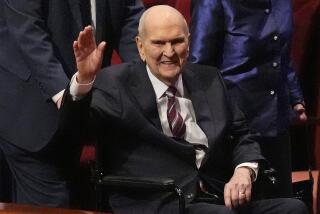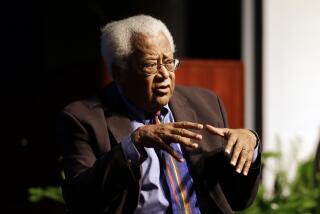Mormon Leader Inspiring Hopes of a New, Robust Era for Church : Ordination: Gordon Hinckley, who provided guidance during illnesses of previous presidents, says denominationâs rapid growth is key challenge.
SALT LAKE CITY â It was a startling tableau--a healthy president of the Mormon Church taking questions from surprised reporters.
Few in the ornate lobby of the Joseph Smith Memorial Building knew that it had been 21 years since any man who served as the faithâs âprophet, seer and revelatorâ had held a news conference.
But they realized what they were seeing was rare, and that a statement was being made.
For years, the Church of Jesus Christ of Latter-day Saints had been governed mostly by committee, as presidents who lived to be 90, 94 and 87 became frail, worn out or enfeebled in office.
Enter Gordon B. Hinckley, ordained last Sunday as the 15th president of the fastest-growing religion founded in America.
Before his elevation as world leader of the church, Hinckley served 14 years as a counselor to three previous presidents, and helped guide the denomination through some tumultuous times during the protracted illnesses of his two predecessors--Howard W. Hunter, who died March 3 at the age of 87 after nine months in office, and Ezra Taft Benson, who died at the age of 94 in 1994.
Their tenure included the widely publicized 1993 excommunication of five people who expressed dissenting views or feminist opinions contrary to church teaching. A sixth person was âdisfellowshipedâ--a penalty involving loss of church privileges--after organizing demonstrations on behalf of two professors who were denied tenure at the churchâs Brigham Young University in Provo, Utah.
Shortly thereafter, Hinckley defended the churchâs actions in an interview with the New York Times. He said the church allows a member to âthink as he pleases,â but, âWhen an individual speaks openly and actively and takes measures to enlist others in opposition to the church and its programs and doctrines, then we feel there is cause for action.â
*
On Monday, the 84-year-old Hinckley made a point of standing to deliver a brief statement about his goals as leader of the 9-million-member religion, and to field reportersâ questions, including those about his health.
âI spent one night in the hospital in my life. I was past 75 when that occurred,â he replied. âThat doesnât mean Iâm ready to run a 100-yard dash.â
By turns candid, humorous and artfully vague, Hinckley appeared every inch the man who pioneered the modern churchâs extensive public relations arm and its use of television and satellite technology to deliver its message.
His robust performance had a galvanizing effect on church employees. There were smiles everywhere, and the switchboard lit up with calls of support from rank-and-file members.
âI was delighted to see the church take this kind of step forward. I, for one, hope this is the first of many of these kinds of experiences,â said Bruce Olsen, managing director of church Public Affairs Department.
D. Michael Quinn, author of a two-volume work on the Mormon hierarchy, said that while mainstream members are sensitive to gibes about placing their faith in a gerontocracy, their excitement with Hinckleyâs strong advent has a softer center.
âI think itâs more a sense of relief that the leadership of the church, which they love, is no longer burdened that way,â he said.
It is virtually impossible to overstate the reverence Mormons feel toward their âliving prophet,â as one chosen by God to receive divine revelation. That choosing is done by a tradition of apostolic succession in which the churchâs most senior apostle becomes president at the death of his predecessor.
The model for all Mormon presidents is church founder Joseph Smith, who said he was visited by God and Jesus Christ and told to restore âthe only true and living church on the face of the Earth.â
Since its beginnings in Upstate New York in 1830, the church has doubled in size every 15 years, growing to 9 million members, including an expanding missionary force of 50,000. Soon there will be more Mormons abroad than in the United States.
Indeed, Hinckley identified rapid growth as the churchâs main challenge heading into the 21st Century.
Quinn and others believe Hinckley, who has worked in the church bureaucracy and hierarchy for 60 years, is especially well-suited to the formidable task of reconciling Utah Mormonism to Third World cultures.
âI expect to see many more innovations in adapting to the different cultures and backgrounds of the people in all the world,â said Bruce A. Van Orden, associate professor of church history at Brigham Young University.
The grandson of Mormon pioneers and a native of Salt Lake City, Hinckley has been a church official since ending his missionary service, required of all Mormon men, in 1935. In 1937, he became a member of the churchâs Sunday School Board and later organized what became the churchâs public affairs office.
In 1951, he was named executive secretary of the General Missionary Committee, managing the denominationâs entire missionary program. In 1961, Hinckley was named to the Council of Twelve Apostles.
In his news conference Monday, Hinckley took pains to reassure the membership that his would be a presidency built on the foundations he safeguarded as a counselor to three presidents.
âOur theme will be to carry on the great work which has been furthered by our predecessors who have served so admirably, so faithfully and so well with the great traditions of this church,â he said.
âBuilding family values, yes. Fostering education, yes. Building a spirit of tolerance and forbearance among people everywhere, yes. And proclaiming the Gospel of Jesus Christ.â
But the fact remains, Van Orden said, that during his many years as de facto leader of the church when presidents were incapacitated by age, Hinckley was often heard to say: âThis is a decision that can only be made by a president of the church.â
âHe felt he had no authority to make decisions for anyone else,â Van Orden said. âBut now he can.â
More to Read
Sign up for Essential California
The most important California stories and recommendations in your inbox every morning.
You may occasionally receive promotional content from the Los Angeles Times.










